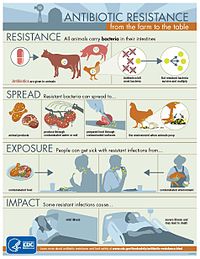
Photo from wikipedia
Non-prescription antibiotic use (using antibiotics without clinical guidance) increases the risk of the development of antibiotic resistance, adverse drug reactions, and other potential patient harm. Few studies have explored non-prescription… Click to show full abstract
Non-prescription antibiotic use (using antibiotics without clinical guidance) increases the risk of the development of antibiotic resistance, adverse drug reactions, and other potential patient harm. Few studies have explored non-prescription use in children in the U.S. From January 2021 to April 2022, a diverse sample of caregivers of children under 18 years were surveyed in English and Spanish at two safety net clinics in Texas. We assessed the prevalence of antibiotic use in children in the previous 12 months, storage of antimicrobials, and intended use of non-prescription antibiotics (professed intention for future non-prescription antibiotic use). We also measured sociodemographic factors, types of antibiotics used, and symptoms that trigger non-prescription use. The response rate was 82%, and 17% were surveyed in Spanish. Of 322 participants surveyed, three Spanish-speaking caregivers reported giving non-prescription antibiotics to their child in the previous 12 months. Approximately 21% (n = 69) reported storing antimicrobials at home, specifically amoxicillin (n = 52), clindamycin (n = 10), cephalexin (n = 5), penicillin (n = 3), and trimethoprim/sulfamethoxazole (n = 3). Nearly 15% (n = 46) reported intention to give non-prescription antibiotics to their children. Younger caregiver age was associated with storage and intended use of non-prescription antibiotics. Our findings will guide the development of an educational intervention to decrease non-prescription antibiotic use.
Journal Title: Antibiotics
Year Published: 2023
Link to full text (if available)
Share on Social Media: Sign Up to like & get
recommendations!